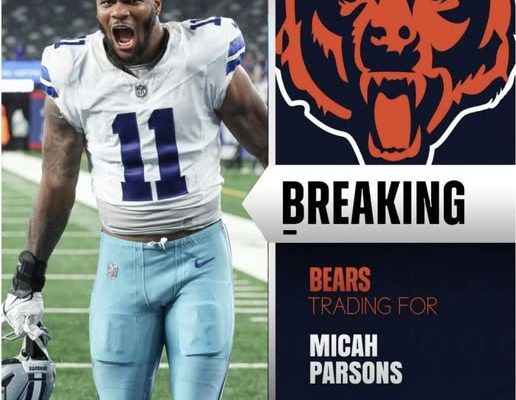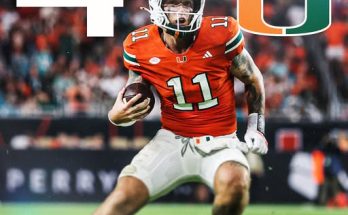Breaking news out of the NFL has sent shockwaves through the football world, as reports have surfaced indicating that the Dallas Cowboys are attempting to finalize a blockbuster trade that would send four-time Pro Bowl defensive end Micah Parsons to the Chicago Bears. According to insider Adam’s sources, talks between the two franchises have been quietly but intensely ongoing over the past several days, and the framework of a deal appears to be taking shape, though significant details are still being ironed out. This development is nothing short of seismic for both teams, the league, and fans who have watched Parsons grow into one of the NFL’s most electrifying and dominant defensive forces since entering the league. The very idea of Parsons donning the navy and orange of Chicago is enough to spark debates, speculation, and intense curiosity about the motivations behind such a move and the implications it could have for both organizations’ futures.
For Dallas, trading away Parsons would be a decision that fundamentally alters the identity of their defense. Since being drafted in the first round in 2021, Parsons has not only lived up to expectations—he has exceeded them in almost every measurable way. His combination of speed, power, and relentless motor has made him one of the most feared pass rushers in the game, a player capable of taking over games and single-handedly wrecking an opposing offense’s game plan. He has become the focal point of Dallas’s defense, drawing double teams, forcing hurried throws, and piling up sacks, tackles for loss, and quarterback pressures at a rate few players can match. For Cowboys fans, he has represented not just a defensive star but a symbol of the team’s hopes for ending a decades-long Super Bowl drought. Moving on from him, therefore, would signal either a dramatic shift in strategy, a breakdown in contract negotiations, or some behind-the-scenes tension that the public is only beginning to hear whispers about.
From Chicago’s perspective, the chance to acquire Parsons is the type of rare opportunity that could completely change the trajectory of a franchise. The Bears have been in the midst of a rebuild, with general manager Ryan Poles reshaping the roster and accumulating draft picks while trying to find and develop a franchise quarterback in Justin Fields. Their defense, while showing signs of improvement, has lacked a true, game-changing pass rusher who can tilt the field in their favor. Parsons would instantly fill that void, giving the Bears a defensive centerpiece around which to build. Chicago has a proud tradition of dominant defensive players—from Dick Butkus to Mike Singletary to Brian Urlacher and Khalil Mack—and Parsons would fit right into that legacy, potentially becoming the heart and soul of the defense for years to come. In a city that reveres defense as much as any in the league, Parsons’ arrival would be a marketing dream and a football upgrade of the highest order.
The question that arises immediately is: why would the Cowboys even entertain such a deal? The answer likely lies in the complex calculus of NFL roster management, salary cap constraints, and long-term planning. Parsons is eligible for a massive contract extension, and given the exploding market for elite pass rushers, he is expected to command a deal that could surpass the \$30 million per year mark. While Dallas has shown a willingness to pay top talent, they have also faced difficult decisions in the past when balancing multiple high-priced contracts for stars like Dak Prescott, CeeDee Lamb, and others. If the front office believes that committing that much of the salary cap to one defensive player could hinder their ability to build a more balanced roster, they might see moving Parsons now—while his value is sky-high—as a way to recoup multiple premium assets, such as early-round draft picks and perhaps even a young, cost-controlled player who can contribute immediately.
There is also the possibility that the Cowboys are looking to shake things up after another postseason disappointment. Despite a roster loaded with talent, Dallas has not advanced beyond the divisional round since the mid-1990s, and owner Jerry Jones has never been shy about making bold, attention-grabbing moves. Trading Parsons would undoubtedly be one of the boldest moves of his tenure, but Jones has always balanced his desire to win now with his knack for keeping the Cowboys in the headlines. By making such a high-profile trade, the team could reposition itself for both short-term competitiveness and long-term flexibility, especially if they receive a king’s ransom in return.
For the Bears, the potential cost of acquiring Parsons will be steep. Chicago would almost certainly need to part with at least one first-round pick—possibly more—as well as additional high draft selections or a combination of picks and players. Given Parsons’ age, production, and contract situation, Dallas has every reason to demand a massive return. For a team in Chicago’s position, the question becomes whether the addition of Parsons accelerates their rebuild enough to justify parting with valuable future assets. If the Bears believe they are close to contending for a playoff spot or even a division title, Parsons could be the missing piece that turns that belief into reality. But if they are still a year or two away, they must weigh the risk of sacrificing draft capital that could be used to bolster other areas of the roster.
One factor working in Chicago’s favor is their cap space. The Bears have one of the more favorable salary cap situations in the league, meaning they can not only afford to trade for Parsons but also extend him to the kind of long-term contract he will command without severely restricting their financial flexibility. This could give them a leg up over other potential suitors, as Dallas would likely prefer to trade Parsons to a team that can both afford him and send back substantial value.
The fan reactions to this news are predictably intense and polarized. Cowboys supporters are grappling with the idea of losing a player who has quickly become one of the faces of the franchise, and many will view any return package as inadequate unless it is overwhelming. Bears fans, on the other hand, are buzzing with the possibility of landing a superstar in his prime, someone who can help restore the team’s identity as a defensive powerhouse. Social media is already flooded with hypothetical trade proposals, debates about Parsons’ value, and predictions of how he might transform Chicago’s defense.
The timing of the report is also notable, coming as teams are deep into their offseason programs and gearing up for training camp. If the trade is finalized before camp begins, Parsons would have time to integrate into the Bears’ defensive system, learn the playbook, and build chemistry with his new teammates. That could be crucial in maximizing his impact from Week 1. For Dallas, the sooner they complete the deal, the sooner they can use the acquired assets to address other needs, whether through additional trades, free-agent signings, or future draft selections.
In the broader context of the NFL, a trade of this magnitude would send ripples through the league. Opposing offensive coordinators in the NFC North would have to completely rethink their game plans to account for Parsons’ presence, while teams in the NFC East might view Dallas as slightly less fearsome defensively, at least in the short term. Other pass rushers around the league could also see their market values rise as a result of Parsons resetting expectations for elite defenders’ worth in both trade compensation and contract dollars.
Ultimately, whether this deal happens will come down to whether the Cowboys feel the return is worth parting with a generational talent and whether the Bears are willing to pay the steep price in both assets and dollars. For now, the situation remains fluid, with both sides reportedly engaged in active discussions. If the trade is consummated, it will instantly rank among the most significant NFL transactions in recent memory, with the potential to reshape the fortunes of two storied franchises. Until then, fans and analysts alike will be glued to every update, dissecting every rumor, and imagining the shockwave moment when Micah Parsons is officially introduced in a Bears uniform—a moment that would not only change the outlook for the 2025 season but could alter the balance of power in the NFL for years to come.



